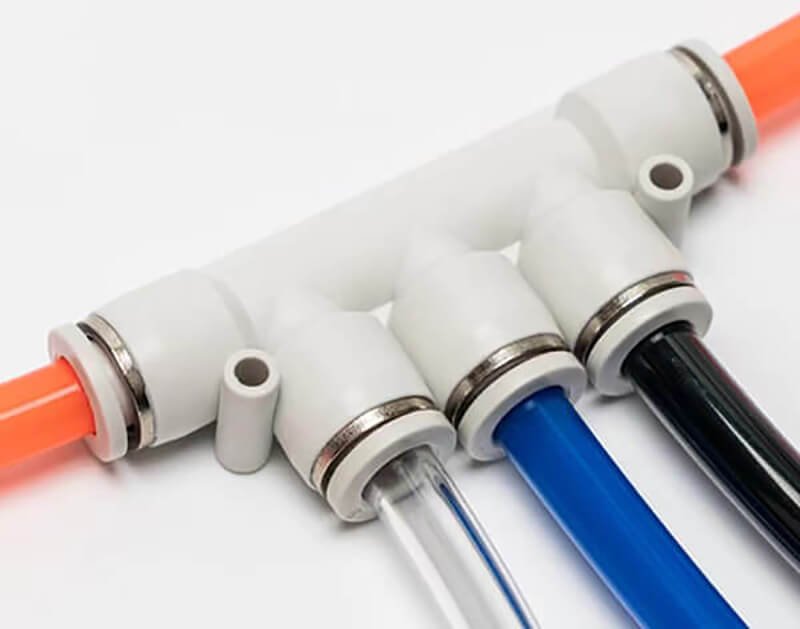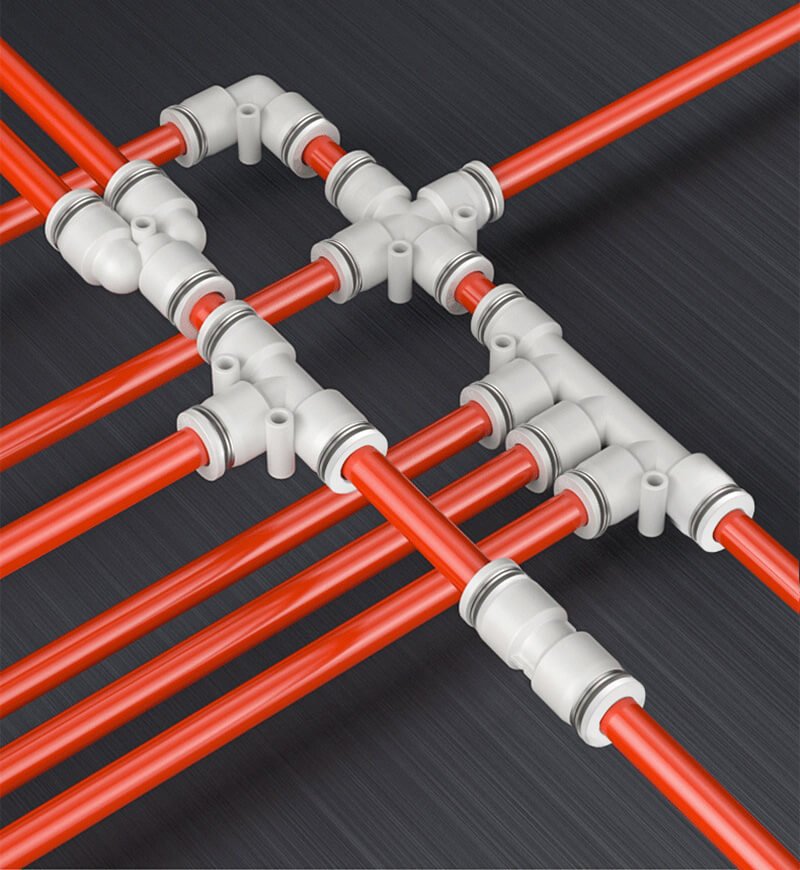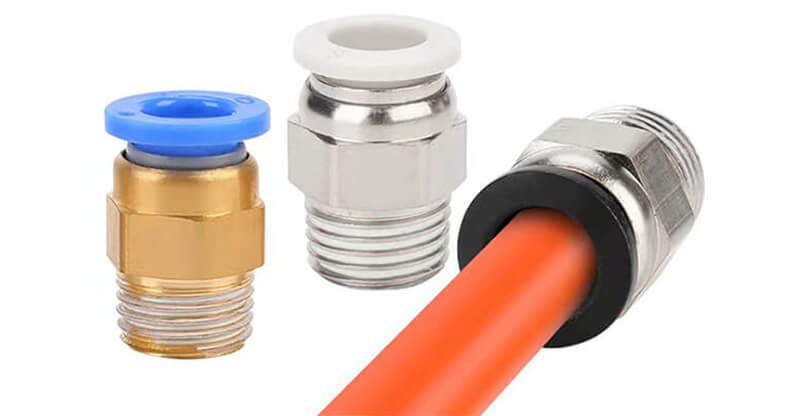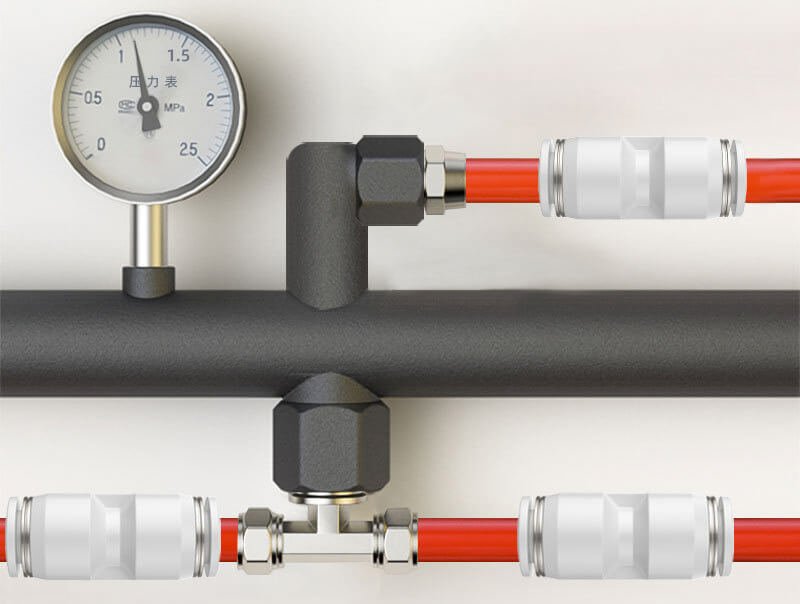Pneumatic systems are widely used in many industries, from manufacturing to automotive, for their ability to control the movement of machinery and equipment with compressed air. These systems rely heavily on pneumatic fittings and connectors, which allow various components to work together seamlessly. However, for these systems to function properly, it’s essential to consider the pressure and temperature ratings of the fittings being used.
In this article, we will explore the significance of pressure and temperature ratings in pneumatic fittings.
What are Pressure and Temperature Ratings?
Pressure Rating
The pressure rating of a pneumatic fitting refers to the maximum pressure the fitting can safely handle during operation. This rating is determined by factors such as the material of the fitting, its design, and the strength of the seals used. The pressure rating is typically expressed in pounds per square inch (PSI) or bar.
- Working Pressure: The maximum pressure a fitting is designed to handle during regular operation. Exceeding this pressure can lead to damage or failure of the fitting.
- Burst Pressure: The pressure at which a fitting will fail catastrophically. It’s a safety threshold that provides an indication of the extreme pressure a fitting can endure before breaking.
- Test Pressure: A pressure that is used for testing the integrity of a fitting, often higher than the working pressure, but short-term and done in controlled conditions.
Exceeding any of these pressures can cause leaks, ruptures, or other catastrophic failures, so understanding the pressure rating of each fitting is essential to ensure the system operates safely and efficiently.
Temperature Rating
The temperature rating refers to the range of temperatures within which a pneumatic fitting can function without losing its integrity. Like pressure, temperature affects the material properties of the fitting, including flexibility, strength, and resistance to wear. The temperature rating is typically given as a minimum and maximum temperature, in degrees Celsius or Fahrenheit.
- Low-Temperature Rating: Some fittings are designed for use in cold environments and can withstand freezing temperatures without becoming brittle or cracking.
- High-Temperature Rating: Fittings used in high-temperature environments, such as those near hot machinery or exhaust systems, need to maintain their performance at elevated temperatures without softening or degrading.
Understanding the temperature rating of fittings is crucial, especially in environments where extreme heat or cold is present. Using fittings outside their rated temperature range can lead to premature failure, leaks, or system inefficiency.

Importance of Pressure Ratings
Why Pressure Ratings Matter
The pressure rating of a pneumatic fitting is one of the most important specifications to consider when designing or maintaining a pneumatic system. It ensures that the fitting can safely handle the pressure from the compressed air without breaking, leaking, or malfunctioning. If a fitting is exposed to higher pressures than it is rated for, it could fail, resulting in costly repairs and safety hazards.
Types of Pressure Ratings
- Working Pressure: This is the standard pressure at which a fitting is expected to perform during normal operation. It is crucial to select a fitting with a working pressure that matches or exceeds the system’s requirements.
- Burst Pressure: The burst pressure represents the maximum pressure a fitting can tolerate before it ruptures. While it is not a pressure you should ever aim for, it helps you understand the safety limits of the fitting.
- Test Pressure: Test pressure is typically higher than the working pressure and is used to test the integrity of the system. This gives you confidence that the fitting can withstand occasional stress without failure.
Consequences of Exceeding Pressure Ratings
Exceeding the pressure rating can cause leaks, fitting failure, or even damage to other components in the pneumatic system. The pressure might cause the fitting to burst, which could result in loss of control over the system, creating dangerous situations for workers or damage to equipment. It could also lead to costly downtime and repairs.
By carefully selecting fittings with appropriate pressure ratings, you help prevent these risks and maintain a safe and efficient system.
Importance of Temperature Ratings
Why Temperature Ratings Matter
Just like pressure, temperature plays a significant role in the performance of pneumatic fittings. Each material used in the manufacturing of pneumatic fittings has a specific temperature tolerance, and it is essential to respect these limits to ensure that the fitting functions properly throughout its life cycle. Temperature extremes can impact the flexibility, strength, and seal integrity of the fitting, leading to system failures or inefficiency.
Effects of Temperature on Fittings
- High Temperatures: When fittings are exposed to temperatures higher than their rated maximum, the material of the fitting can soften, warp, or degrade. This can cause the fitting to lose its shape, leading to leaks or total failure. Overheated fittings may also cause the seals to lose their effectiveness, making the system prone to air loss.
- Low Temperatures: In cold conditions, some materials can become brittle or crack. Fittings exposed to freezing temperatures may fail to seal properly, or they may become too fragile to withstand normal pressure.
Choosing the Right Fittings for Temperature
Selecting a fitting with an appropriate temperature rating for your environment is essential. For instance, if your system operates in a high-heat area, you need to choose fittings made from materials that can withstand those high temperatures without failing. Likewise, fittings in cold environments should be rated for low temperatures to prevent brittleness.

Factors Affecting Pressure and Temperature Ratings
Material of the Fitting
The material used to make a pneumatic fitting plays a major role in determining both its pressure and temperature ratings. Different materials have different strengths and resistances to heat and cold.
- Metals like brass and stainless steel typically offer higher pressure ratings and can handle higher temperatures. These materials are durable and resistant to wear.
- Plastics or composites may have lower pressure ratings but can be designed to perform well in certain temperature ranges. However, they might not be suitable for extreme temperatures.
Fitting Design
The design of the fitting also affects its performance under pressure and temperature. A well-designed fitting ensures that the material is used efficiently, making it capable of handling more pressure or temperature variation.
- Threaded fittings tend to have a higher pressure rating because the threaded connections are tighter and more secure.
- Push-to-connect fittings are convenient but might have slightly lower pressure ratings due to the simplicity of their design.
Seal Types
The seal is a critical component in maintaining the pressure and temperature integrity of a fitting. Seals made from rubber or silicone are good for sealing but may not withstand extreme temperatures. Metal seals offer better resistance to high temperatures but may require special lubrication at higher pressures.
Environmental Conditions
External conditions such as exposure to chemicals, humidity, or UV light can degrade the fitting material over time. It’s essential to consider the working environment and the potential for these factors to impact the fitting’s performance.
- Fittings exposed to harsh chemicals may require chemical-resistant materials.
- Fittings used outdoors may need to be resistant to UV radiation and weathering.
Manufacturing Standards
Fittings that adhere to industry standards are generally tested for pressure and temperature endurance. These standards ensure that the fittings are manufactured to handle specific environmental and operational conditions safely.
How to Choose Fittings Based on Pressure and Temperature Ratings
Step 1: Understand Your System’s Requirements
The first step in choosing the right pneumatic fittings is to understand the specific needs of your system. Consider the following:
- What is the working pressure of your system?
- Will your system be exposed to high or low temperatures?
- What are the environmental conditions where the fitting will be used?
Once you have a clear understanding of these factors, you can narrow down your options based on the required ratings.
Step 2: Choose Fittings with Appropriate Pressure Ratings
Look for fittings that match or exceed the working pressure of your system. It’s always better to choose fittings with a higher pressure rating than necessary to provide an additional margin of safety.
- For systems with high-pressure needs, stainless steel fittings are often a good choice due to their strength.
- For systems with lower pressure, brass or plastic fittings may be sufficient and more cost-effective.
Step 3: Choose Fittings with the Right Temperature Ratings
Consider the maximum and minimum temperatures your system will experience. Select fittings that can handle these extremes:
- High-temperature environments (e.g., near engines or hot machinery) require fittings made of metal or specialized materials designed to withstand heat.
- Low-temperature environments (e.g., refrigeration or outdoor settings) require fittings made from cold-resistant materials like certain plastics or metals designed to maintain their strength in freezing conditions.
Step 4: Factor in the Environment
If your system will be exposed to harsh chemicals, moisture, or extreme weather, you should select fittings that are corrosion-resistant and designed for high durability. For example, brass or stainless steel fittings are commonly chosen for their resistance to corrosion and long-lasting performance in tough environments.
Step 5: Review Industry Standards and Certifications
Always check for industry certifications that ensure the fittings meet safety and quality standards for pressure and temperature ratings. Fittings that conform to ISO, SAE, or other recognized standards offer an added layer of assurance that they can handle the required pressures and temperatures.

Common Issues and How to Address Them
1. Pressure Rating Issues
One of the most common issues that occur in pneumatic systems is the exceeding of pressure ratings. When the pressure surpasses the rated limits of the fittings, it can lead to leaks, ruptures, or even catastrophic system failure.
- Solution: Always ensure that the fittings selected are rated for higher pressures than the maximum operating pressure of your system. Pressure regulators can also be used to maintain the pressure within safe limits.
2. Temperature Rating Issues
Fittings exposed to temperatures outside their rated range can suffer from degradation or loss of integrity. For example, fittings exposed to high heat can soften or warp, while fittings in cold environments can become brittle and crack.
- Solution: Select fittings that are specifically rated for the operating temperature range of your system. For high-temperature environments, choose metal fittings and ensure seals are heat-resistant. For cold environments, use cold-resistant plastics or metal alloys that maintain their strength.
3. Material Compatibility Issues
The materials used in pneumatic fittings may not be compatible with the chemicals, moisture, or environmental conditions they are exposed to. This can lead to corrosion, degradation, or leaks.
- Solution: Choose fittings made from corrosion-resistant materials like stainless steel or brass for systems exposed to chemicals or moisture. If chemicals are involved, check the chemical resistance of the fitting material.
4. Seal Failures
Seals in pneumatic fittings can wear out over time, leading to leaks and loss of pressure. Overexposure to extreme pressure or temperature can cause the seals to fail prematurely.
- Solution: Regularly inspect seals and replace them as necessary. Choose fittings with high-quality O-rings or seals that are made from temperature-resistant materials to extend their lifespan.
Industry Standards and Certifications
Why Industry Standards Matter
When selecting pneumatic fittings, it’s essential to ensure they meet recognized industry standards and certifications. These standards ensure that the fittings have been tested for pressure, temperature, and safety under various conditions.
Common Standards
- ISO 9001: This standard covers quality management systems, ensuring that fittings are manufactured with consistent quality and reliability.
- SAE (Society of Automotive Engineers): SAE standards are widely used in pneumatic and hydraulic systems, providing specifications for pressure and material strength.
- DIN (German Institute for Standardization): DIN standards are often used for mechanical engineering and ensure that fittings meet rigorous design and material criteria.
Certifications to Look For
- CE Marking: Indicates compliance with European safety, health, and environmental protection standards.
- UL (Underwriters Laboratories): Certification that ensures the fittings are safe for use in electrical and mechanical systems.
- NSF Certification: For fittings used in systems that handle drinking water, NSF certification ensures the product meets safety and material requirements.
By choosing fittings that adhere to these standards and certifications, you can be confident that they will meet the required performance, safety, and durability criteria for your pneumatic system.
Conclusion
Pressure and temperature ratings are fundamental to the safe and efficient operation of pneumatic systems. By understanding the importance of these ratings and considering factors like material, design, and environmental conditions, you can ensure that your fittings perform optimally and safely throughout their lifespan.
To prevent common issues such as overpressure or temperature-related failures, it is crucial to choose fittings that match the specific requirements of your system. Additionally, adhering to industry standards and certifications will provide further assurance that your fittings are reliable and built to last.


